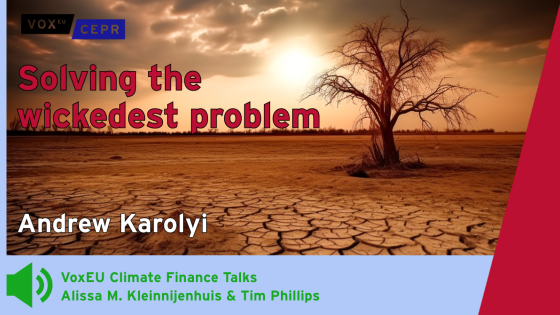While the crisis may not be over, we can still pause and take stock. What lessons should we take away from the turmoil that began in early August 2007? Most of what I will discuss is not new. But recent events have brought some important issues into better focus. Reflecting on the central causes of the problems we currently face leads me to conclude: there will always be a next crisis.
Its centrality to industrial economic activity, combined with a potential for abuse, has made the financial system is one of the most heavily regulated part of our economy. Through a variety of regulators and supervisors with overlapping responsibilities, governments make voluminous rules and then set out to enforce them. The idea of a laissez faire financial system makes no sense even to most ardent champions of the free market.
Even with intense oversight by the governmental authorities – in the United States we have the Office of the Comptroller of the Currency, the Federal Deposit Insurance Corporation and the Federal Reserve, as well as state banking authorities – crises continue to come. One reason for this is the natural tendency of officials to fight the last battle; looking for systemic weaknesses revealed by the most recent crisis. So, when complex automated trading schemes were thought to have contributed to the October 1987 stock market crash, circuit breakers were put in place that shut down computers-based order systems when indices move by more than a certain amount. In the aftermath of the Asian crisis, the IMF created new lending facilities in an attempt to address issues of contagion – in essence, to deal with countries that were innocent victims of problems created elsewhere. And when LTCM collapsed there was a flurry of activity to understand and the potential impact of what were called “highly leveraged institutions”.
As necessary as each of these reforms may have been, we are not going to stop tomorrow’s crises by looking backward. Financial innovators will always seek out the weakest point in the system. Innovations will both exploit flaws in the regulatory and supervisory apparatus, and manipulate the inherent limitations of the relationship between asset managers and their investor clients. The 2007 crisis provides examples of both of these. Let’s look at each in turn.
Innovations exploited flaws in the regulatory and supervisory apparatus
Financial institutions have been allowed to reduce the capital that they hold by shifting assets to various legal entities that they did not own – what we now know refer to as “conduits” and “special investment vehicles” (SIV). (Every financial crisis seems to come with a new vocabulary.) Instead of owning the assets, which would have attracted a capital charge, the banks issued various guarantees to the SIVs; guarantees that did not require the banks to hold capital.
The purpose of a financial institution’s capital is to act as insurance against drops in the value of its assets. The idea is that even if some portion of a bank’s loan portfolio goes bad, there will still be sufficient resources to pay off depositors. Since capital is expensive, bank owners and managers are always on the lookout for ways to reduce the amount they have to hold. It is important to keep in mind that under any system of rules, clever (and very highly paid) bankers will always develop strategies for holding the risks that they wanted as cheaply as they can, thereby minimizing their capital.
Manipulation of the asset manager-client relationship
But this is not the only problem. Financial innovators will also seek ways in which to exploit the relationship between the ultimate investor (the principal) and the managers of the investor’s assets (the agent). The problem is that the agent acts primarily in his or her personal interest, which may or may not be the same as the interest of the principal. The principal-agent problem is impossible to escape.
Think about the manager of a pension fund who is looking for a place to put some cash.
Rules, both governmental and institutional, restrict the choices to high-rated fixed-income securities. The manager finds some AAA-rated bond that has a slightly higher yield than the rest. Because of differences in liquidity risk, for example, one bond might have a yield that is 20 or 30 basis points (0.30 or 0.30 percentage points) higher. Looking at this higher-yielding option, the pension-fund manager notices that there is a very slightly higher probability of a loss. But, on closer examination, he sees that this higher-yielding bond will only start experiencing difficulties if there is a system-wide catastrophe. Knowing that in the event of crisis, he will have bigger problems that just this one bond, the manager buys it; thereby beating the benchmark against which his performance is measured.I submit that there is no way to stop this. Managers of financial institutions will always search for the boundaries defined by the regulatory apparatus, and they will find them. After all, detailed regulations are a guide for how to legally avoid the spirit of the law. And the more detailed the rules, the more ingenious the avoidance. This brand of ingenuity is very highly rewarded, so I am sure these strategies will continue.
Conclusions
So, what to do? Both individuals and government officials need to make adjustments. Individual investors need to demand more information and they need to get it in a digestible form. As individuals we should adhere to the same principle that President Ronald Reagan followed in agreements over nuclear weapons with the Soviet Union: Trust, but verify. We should insist that asset managers and underwriters start by disclosing both the detailed characteristics of what they are selling together with their costs and fees. This will allow us to know what we buy, as well understand the incentives that our bankers face.
As for government officials, most of the lessons point to clarifying the relative riskiness associated with various parts of the financial system. Elsewhere I have suggested that at least some of the problems revealed by the current crisis can be ameliorated by increasing the standardization of securities and encouraging trading to migrate to organized exchanges.
Next columns
In the next essays in this series I will continue along this theme. Part 2 discusses the lesson I have taken away from the Bank of England’s recent experience – that a lender of last resort is no substitute for deposit insurance. In Part 3, I address whether central banks should have a direct role in financial supervision, concluding that they should. And finally, in Part 4, I examine whether central bank actions have created moral hazard, encouraging asset managers to take on more risk than is in society’s interest. My answer is no.
Deposit insurance has a dramatic impact on the amount of capital a bank holds. With deposit insurance, depositors do not care about the assets on their bank’s balance sheet. And without supervision from their liability holders (the depositors) there is a natural tendency to increase the risk that they take. The bank’s owners and managers get the upside if the higher-risk loans and investments yield high returns, while the deposit insurer faces the downside if the risky assets fail to do not payoff. The response to this is to regulate banks and force them to hold capital.
The argument that follows is due to Joshua D. Coval, Jakub W. Jurek, and Erik Stafford, “Economic Catastrophe Bonds,” Harvard Business School Working Paper 07-102, June 2007.
I made this proposal initially in “A Better Way to Organize Securities Markets” Financial Times, 4 October 2007, and provide more details in “Preparing for the Next Financial Crisis” published initially at www.eurointelligence.com on 5 November 2007, and reprinted at www.voxeu.com on 18 November 2007.



